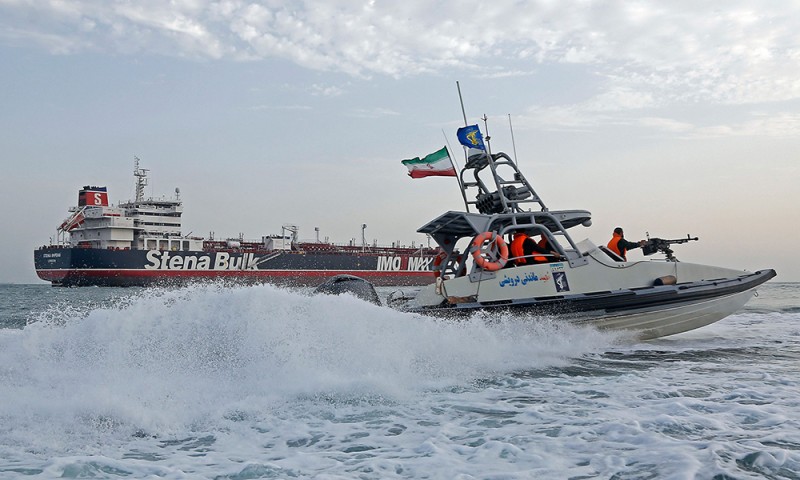
随着以伊双方停火,这场持续12天的战争暂时告一段落。美国总统特朗普6月24日称,以色列和伊朗的停火协议已生效。以色列宣布接受停火,伊朗方面宣布取得胜利。
霍尔木兹海峡作为全球能源贸易的关键咽喉要道,安全风险仍然困扰着船东和来往船只。周一该水道仍保持畅通,不过部分油轮已选择绕行该海峡。
根据美国能源信息署(EIA)的数据,平均每天有2000万桶石油经由该海峡运输,约占全球石油液体消费量的20%和全球海运石油贸易总量的四分之一。
美国能源信息署称,除石油外,去年全球约五分之一的液化天然气贸易也经霍尔木兹海峡运输,这些液化天然气主要来自卡塔尔。
鉴于霍尔木兹海峡对能源贸易的重要性,若其遭遇封锁,将引发市场剧烈动荡。德意志银行外汇研究主管乔治·萨拉维洛斯(George Saravelos)本月早些时候在一份报告中估计,在最糟糕的情形下——伊朗石油供应完全中断且霍尔木兹海峡被封锁——油价或升至每桶120美元以上,较当前布伦特原油价格高出56%。
任何封锁行动都可能涉及动用水雷、巡逻艇、飞机、巡航导弹和柴油潜艇。尽管美国海军已在该地区部署实力强劲的舰队,但清除海峡障碍可能需要数周甚至数月时间。

但存在替代路线可帮助缓解封锁带来的部分影响。
例如,根据美国能源信息署的数据,沙特阿拉伯国家石油公司(Saudi Aramco)运营的一条原油管道从波斯湾附近的阿布盖格石油加工中心向东西方向延伸,最终连通至红海沿岸的延布港。
阿拉伯联合酋长国还运营着另一条管道,该管道绕过霍尔木兹海峡,将陆上油田与位于阿曼湾的富查伊拉出口终端连接起来。
美国能源信息署估计,沙特和阿联酋的输油管道每天可将260万桶石油从霍尔木兹海峡分流出去。
相比之下,沙特去年经该海峡出口的原油和凝析油达每天550万桶。
伊朗在阿曼湾拥有一条输油管道及一个出口终端,借此可绕过霍尔木兹海峡。该管道日输送能力约为30万桶,然而实际使用量却远低于这一水平。据美国能源信息署数据显示,2024年夏季,伊朗经此替代路线的日出口量不足7万桶,且自2024年9月起便已停止装货。
相比之下,伊朗去年平均每天约150万桶的石油出口量中,绝大多数都是经由霍尔木兹海峡运输。
许多分析师认为伊朗封锁海峡的可能性较低,因为此举将严重损害本国经济,并可能引发美国采取灾难性报复行动。
本月早些时候,前中情局波斯湾军事分析师、前国家安全委员会波斯湾事务主任肯尼斯·波拉克(Kenneth Pollack)在《外交事务》杂志的专栏文章中指出,伊朗封锁霍尔木兹海峡的可能性极低。
他预测,伊朗将迅速从“大多数国家眼中的同情对象转变为危险的敌对方”,西方国家将动用武力重新开放该海峡。
波拉克补充道:“伊朗还需担心,此类对全球经济构成威胁的鲁莽行为,将使华盛顿认定伊朗政权必须被推翻。这种担忧在唐纳德·特朗普[(他于2020年1月下令击杀伊朗将军卡西姆·苏莱曼尼(Qassem Soleimani)]重新执政后无疑更为强烈。”(*)
译者:中慧言-王芳
随着以伊双方停火,这场持续12天的战争暂时告一段落。美国总统特朗普6月24日称,以色列和伊朗的停火协议已生效。以色列宣布接受停火,伊朗方面宣布取得胜利。
霍尔木兹海峡作为全球能源贸易的关键咽喉要道,安全风险仍然困扰着船东和来往船只。周一该水道仍保持畅通,不过部分油轮已选择绕行该海峡。
根据美国能源信息署(EIA)的数据,平均每天有2000万桶石油经由该海峡运输,约占全球石油液体消费量的20%和全球海运石油贸易总量的四分之一。
美国能源信息署称,除石油外,去年全球约五分之一的液化天然气贸易也经霍尔木兹海峡运输,这些液化天然气主要来自卡塔尔。
鉴于霍尔木兹海峡对能源贸易的重要性,若其遭遇封锁,将引发市场剧烈动荡。德意志银行外汇研究主管乔治·萨拉维洛斯(George Saravelos)本月早些时候在一份报告中估计,在最糟糕的情形下——伊朗石油供应完全中断且霍尔木兹海峡被封锁——油价或升至每桶120美元以上,较当前布伦特原油价格高出56%。
任何封锁行动都可能涉及动用水雷、巡逻艇、飞机、巡航导弹和柴油潜艇。尽管美国海军已在该地区部署实力强劲的舰队,但清除海峡障碍可能需要数周甚至数月时间。
但存在替代路线可帮助缓解封锁带来的部分影响。
例如,根据美国能源信息署的数据,沙特阿拉伯国家石油公司(Saudi Aramco)运营的一条原油管道从波斯湾附近的阿布盖格石油加工中心向东西方向延伸,最终连通至红海沿岸的延布港。
阿拉伯联合酋长国还运营着另一条管道,该管道绕过霍尔木兹海峡,将陆上油田与位于阿曼湾的富查伊拉出口终端连接起来。
美国能源信息署估计,沙特和阿联酋的输油管道每天可将260万桶石油从霍尔木兹海峡分流出去。
相比之下,沙特去年经该海峡出口的原油和凝析油达每天550万桶。
伊朗在阿曼湾拥有一条输油管道及一个出口终端,借此可绕过霍尔木兹海峡。该管道日输送能力约为30万桶,然而实际使用量却远低于这一水平。据美国能源信息署数据显示,2024年夏季,伊朗经此替代路线的日出口量不足7万桶,且自2024年9月起便已停止装货。
相比之下,伊朗去年平均每天约150万桶的石油出口量中,绝大多数都是经由霍尔木兹海峡运输。
许多分析师认为伊朗封锁海峡的可能性较低,因为此举将严重损害本国经济,并可能引发美国采取灾难性报复行动。
本月早些时候,前中情局波斯湾军事分析师、前国家安全委员会波斯湾事务主任肯尼斯·波拉克(Kenneth Pollack)在《外交事务》杂志的专栏文章中指出,伊朗封锁霍尔木兹海峡的可能性极低。
他预测,伊朗将迅速从“大多数国家眼中的同情对象转变为危险的敌对方”,西方国家将动用武力重新开放该海峡。
波拉克补充道:“伊朗还需担心,此类对全球经济构成威胁的鲁莽行为,将使华盛顿认定伊朗政权必须被推翻。这种担忧在唐纳德·特朗普[(他于2020年1月下令击杀伊朗将军卡西姆·苏莱曼尼(Qassem Soleimani)]重新执政后无疑更为强烈。”(*)
译者:中慧言-王芳
The Strait of Hormuz avoided Tehran’s initial response to the U.S. bombing of Iran’s nuclear facilities over the weekend, sending oil prices lower.
Still, the Strait of Hormuz is a critical choke point in the global energy trade that could be blocked by Iran. Iranian lawmakers approved its closure after the U.S. attack, but security officials have yet to sign off on it, and the waterway remained open on Monday. Some tankers are steering away from the strait anyway.
According to the U.S. Energy Information Administration (EIA), an average of 20 million barrels of oil a day flow through the strait, or the equivalent of about 20% of global petroleum liquids consumption and about one-quarter of total global seaborne oil trade.
In addition to oil, about one-fifth of global liquefied natural gas trade also passed through the Strait of Hormuz last year, primarily from Qatar, EIA says.
Given its importance to the energy trade, the strait’s closure would cause massive turmoil in markets. In a note earlier this month, George Saravelos, head of FX research at Deutsche Bank, estimated that the worst-case scenario—a complete disruption to Iranian oil supplies and a closure of the Strait of Hormuz—could send oil prices above $120 per barrel. That would represent a 56% increase over the current price of Brent crude.
Any closure might entail use of mines, patrol boats, aircraft, cruise missiles, and diesel submarines. While the U.S. Navy has deployed a formidable array of ships to the region, clearing the strait could take weeks or months.
But there are alternative routes that could help mitigate some of the effects of any closure.
For example, state-run energy giant Saudi Aramco operates a crude oil pipeline that runs east and west from the Abqaiq oil processing center near the Persian Gulf to the port of Yanbu on the Red Sea, according to EIA.
The United Arab Emirates operates another pipeline that bypasses the Strait of Hormuz by linking onshore oilfields to the Fujairah export terminal in the Gulf of Oman.
EIA estimates that the Saudi and UAE pipelines could be used to divert 2.6 million barrels per day from the Strait of Hormuz.
That compares with 5.5 million barrels per day of crude and condensate that Saudi Arabia exported through the strait last year.
Iran also has a pipeline and export terminal on the Gulf of Oman that could bypass the Strait of Hormuz. The pipeline’s capacity is about 300,000 barrels per day, but its actual use has been far less than that. During the summer of 2024, Iran exported fewer than 70,000 barrels per day through that alternate route and stopped loading cargoes after September 2024, according to the EIA.
By contrast, the vast majority of Iran’s oil exports, which averaged about 1.5 million barrels per day last year, go through the Strait of Hormuz.
Many analysts see an Iranian closure of the strait as unlikely since doing so would devastate its own economy in the process and trigger a potentially catastrophic response from the U.S.
In a column in Foreign Affairs magazine earlier this month, Kenneth Pollack, a former CIA Persian Gulf military analyst and former director for Persian Gulf affairs at the National Security Council, said there’s a low probability Iran would close the strait.
That’s because Iran would quickly go from a “sympathetic victim to a dangerous nemesis in the eyes of most other countries,” while Western countries would use force to reopen the strait, he predicted.
“And Tehran would have to worry that such a reckless threat to the world’s economies would convince Washington that the Iranian regime had to be removed,” Pollack added. “That fear is surely greater with U.S. President Donald Trump—who ordered the death of Iranian general Qassem Soleimani in January 2020—back in office.”

